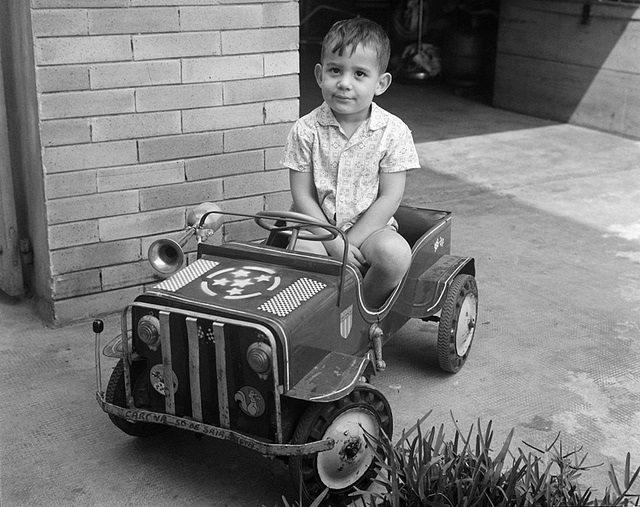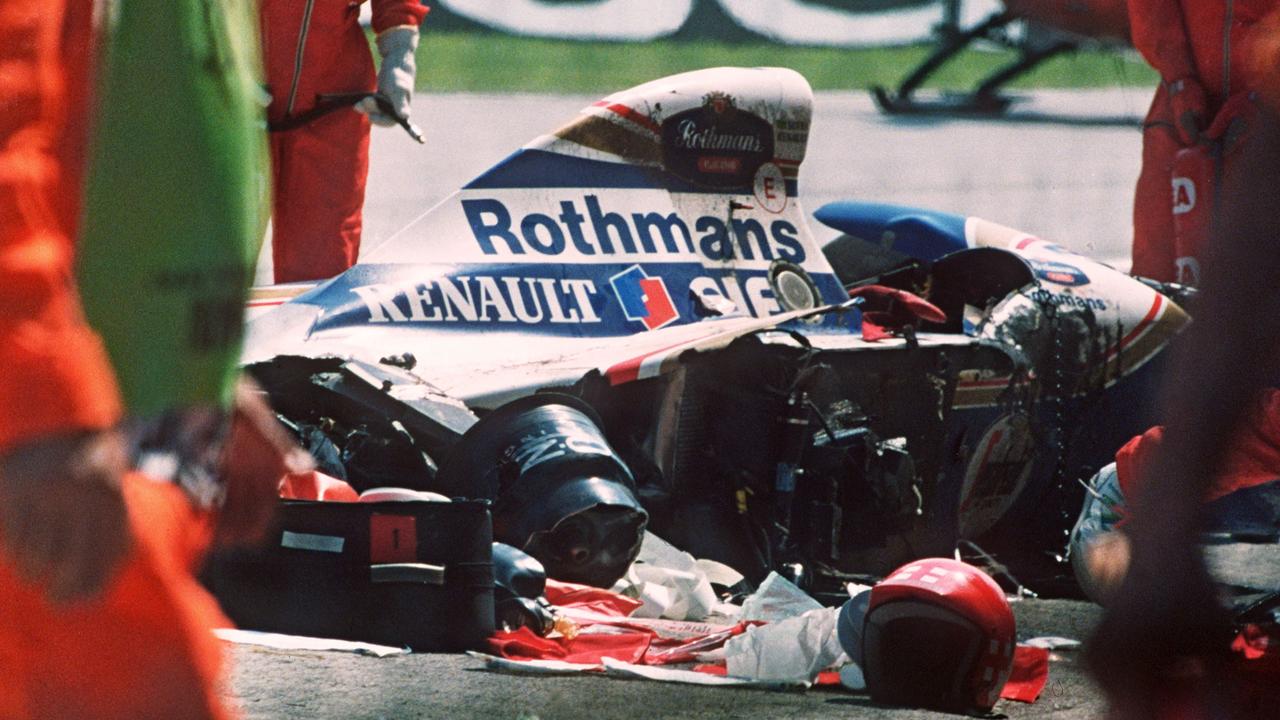Senna was highly athletic, excelling in gymnastics and other sports, and developed an interest in cars and motor racing at the age of four.

Senna’s first kart was built by his father using a small 1-HP lawnmower engine. Senna started racing at Interlagos and entered a karting competition at the age of 13.
He started his first race on pole position, facing rivals who were some years older than him; despite this, he managed to lead most of the race before retiring after colliding with a rival. His father supported his son and Lucio Pascal Gascon soon managed the developing talent.
Senna went on to win the South American Kart Championship in 1977. He contested the Karting World Championship each year from 1978 to 1982, finishing runner-up in 1979 and 1980.

In 1981, Senna moved to Eaton, near Norwich in England, to begin single-seater racing, winning the RAC and Townsend Thoresen Formula Ford 1600 Championships that year with the Van Diemen team.
In 1983, Senna drove in the British Formula Three Championship for the West Surrey Racing team. He dominated the first half of the season until Martin Brundle, driving a similar car for Eddie Jordan Racing, closed the gap in the second part of the championship. Senna won the title at the final round after a closely fought and, at times, acrimonious battle with the Briton.
Formula 1
In 1984 Senna made his debut at the Brazilian Grand Prix with Toleman in Rio de Janeiro, where he qualified 17th but retired when the Hart 415T turbocharger failed on lap 8.
He scored his first World Championship point when he finished 6th in his second race at the South African Grand Prix at Kyalami with severe cramp in his neck and shoulders, and replicated that result two weeks later at the Belgian Grand Prix.

Senna’s best result of the season came at the Monaco Grand Prix, the first wet-weather race of the season. Qualifying 13th on the grid, he made steady progress in climbing through the field, passing Niki Lauda for second on lap 19.
He quickly began to cut the gap to race leader Alain Prost. Before he could attack Prost, the race was stopped on lap 31 for safety reasons.
The next year Senna teamed up with Lotus and at the second round of the season, the Portuguese Grand Prix, Senna took the first pole position of his Formula 1 career. He converted it into his first victory in the race, which was held in very wet conditions, winning by over a minute from the Ferrari of Michele Alboreto.

Throughtout his three years at the team he would rack up 6 wins and over 150pts respectively with his best finish 3rd in the 1987 season.
McLaren
In 1988, due to the relationship he had built up with Honda throughout the 1987 season with Lotus, and with the approval of McLaren’s number-one driver and then-double world champion, Alain Prost, Senna joined the McLaren team.

The foundation for a fierce competition between Senna and Prost was laid, culminating in a number of dramatic race incidents between the two over the next five years.
The pair won 15 of 16 races in the dominant McLaren MP4/4 in 1988 with Senna coming out on top, winning his first Formula One world championship title by taking eight wins to Prost’s seven. Although Prost scored more points over the season, three of his second places were dropped, as only the eleven-best scores counted, meaning that Senna bested Prost by three points.

In 1989, the rivalry between Senna and Prost intensified into numerous battles on the track and a psychological war off it. At the Japenese GP, Prost took the 1989 world title after a collision with Senna at the Suzuka Circuit in Japan, the penultimate race of the season which Senna needed to win to remain in contention for the title.
Prost had managed to leave the grid faster than Senna by removing the gurney flap from his car, which was unbeknownst to Senna. Senna won the race but was later disqualified after re-joining the track illegally after the collision with Prost.
Prost took the title which he would leave McLaren to join rivals Ferrari after the incident took place.

In 1990, Senna took a commanding lead in the championship with six wins, two second-places, and three thirds. With Prost gone to Ferrari, he also had a new teammate in Austrian driver and friend Gerhard Berger.
Interestingly he claimed the title at Japan after he and Prost collided at turn 1 on the opening lap. Controversially at lot of pundits thought the incident was deliberate from Senna after what happened the previous year but nothing came out of the post race report.

In 1991, Senna became the youngest ever three-time world champion, taking seven wins and increasing his pole position record to 60 from 127 events. Prost, because of the downturn in performance at Ferrari, the likes of which littered the team’s history, was no longer a serious competitor.
Last Years With McLaren
In 1992, Senna’s determination to win manifested itself in dismay at McLaren’s inability to challenge Williams’s all-conquering FW14B car. The FW14B, thanks in part to its aerodynamic-enhancing active suspension and powerful Renault V10 engine was much faster and efficient than any other car that season. McLaren’s new car for the season had several shortcomings.

Questions about Senna’s intentions for the upcoming 1993 season lingered throughout 1992, as he did not have a contract with any team by the end of that year. Ferrari had offered him a contract which Senna discussed with Niki Lauda, but decided to decline the offer.
For 1993, attempts were made by McLaren boss Ron Dennis to secure a supply of the dominant Renault V10 engines that Williams had found great success with. When these failed, Senna went to Williams himself and sought to take one of their two open rides, as defending champion Nigel Mansell joined the IndyCar Series for 1993.

Despite Senna going so far as to be willing to forfeit his annual salary just to drive one of Williams’ Renaults, this too would fail. Alain Prost was returning to Formula One for the first time since the penultimate race of the 1991 season. Prost would go on to win the championship and retire at the end of the season.
With this announcement this would pave the way for Senna to join Williams for the 1994 season.
Williams
Rule changes for 1994 had banned active suspension, traction control, and ABS. During preseason testing, the new Williams FW16 car exhibited none of the superiority of the FW15C and FW14B cars that preceded it, and Senna found himself in close running with the Benetton B194 of Michael Schumacher.

The first race of the season was at Interlagos in Brazil, where Senna took pole position. He took an early lead, but Schumacher’s Benetton was never far behind. Schumacher took the race lead after passing Senna in the pits. While trying for a win, he pushed too hard and spun the car coming out of Junção corner on lap 56, stalling it and retiring from the race.
Imola
It was Senna’s worst start to a Formula One season, failing to finish or score points in the first two races, despite taking pole position both times. Schumacher was leading Senna in the Drivers’ Championship by 20 points going into the San Marino GP.
During the afternoon qualifying session, Senna’s compatriot and protégé Rubens Barrichello was involved in a serious accident when his car became airborne at the Variante Bassa chicane and hit the tyre-wall and fence.

During Saturday qualifying, Austrian rookie Roland Ratzenberger was killed after the front wing of his Simtek-Ford broke entering the 310 km/h (190 mph) Villeneuve corner, sending the car into the concrete retaining wall at high speed. Senna immediately visited the accident scene and medical centre.
There he was met by FIA Medical Chief Professor Sid Watkins, who suggested to a tearful Senna that he should retire from racing and take up fishing (a hobby they both shared), to which Senna replied that he could not stop racing.
At the start of the Grand Prix, Senna retained the lead from his chief rival Michael Schumacher, but proceedings were soon interrupted by a startline accident. JJ Lehto’s Benetton-Ford stalled and was hit by the Lotus-Mugen Honda of Pedro Lamy. A wheel and debris landed in the main grandstand, injuring eight fans and a police officer.

The safety car, a sporty version of the Opel Vectra medium family saloon, was deployed for several laps. The Vectra’s lack of speed proved detrimental to the racers, as the slower pace allowed the tyres of the Formula One cars to cool, thus decreasing their pressure. Senna pulled alongside the Vectra and gestured to the driver, Max Angelelli, to increase his speed.
On lap 6, the race resumed and Senna immediately set a quick pace, completing the third-fastest lap of the race, followed by Schumacher.
As Senna rounded the high-speed Tamburello corner on lap 7, his car left the racing line at around 307 km/h (191 mph), ran in a straight line off the track, and hit the concrete retaining wall at around 233 km/h (145 mph), after what telemetry showed to be an application of the brakes for around two seconds. The red flag was shown as a consequence of the accident.

Within two minutes of crashing, Senna was extracted from his race car by Watkins and his medical team, including intensive care anaesthetist Giovanni Gordini.
At 18:40 CEST (16:40 GMT), the head of the hospital’s emergency department, Maria Teresa Fiandri, made the announcement that Senna had died.
Watkins later said that as soon as he saw Senna’s fully dilated pupils, he knew that his brainstem was inactive and that he would not survive. The right-front wheel and suspension are believed to have been sent back into the cockpit, striking Senna on the right side of his helmet, forcing his head back against the headrest.
A piece of upright attached to the wheel had partially penetrated his helmet and made a large indentation in his forehead.
Funeral & Legacy
Senna’s death was considered by many of his Brazilian fans to be a national tragedy, and the government of Brazil declared three days of national mourning. Over half a million people flocked to the streets of Senna’s home city of São Paulo to offer him their salute, the largest funeral procession Sao Paulo had ever seen.
Many safety improvements were made in the sport following Senna’s and Ratzenberger’s deaths and Barrichello’s crash. These include improved crash barriers, redesigned tracks, higher crash safety standards, such as larger sills along the driver cockpit, and major cuts to engine power.

The Instituto Ayrton Senna (English: Ayrton Senna Institute; abbreviated IAS) is a Brazilian non-governmental organization, intended to help create opportunities for human development to young Brazilians in cooperation with businesses, governments, municipalities, schools, universities and NGOs.
The organization is recommended by former Formula One chief executive Bernie Ecclestone, former Williams owner and founder Sir Frank Williams, and former drivers Alain Prost and Gerhard Berger.
Senna was always remembered for his swashbuckling driving. It paved the way for a younger generation of drivers to be brought into F1 with drivers like Sir Lewis Hamilton, Felipe Massa and including his nephew Bruno Senna who would later race in Formula 1.
“If you no longer go for a gap that exists, you are no longer a racing driver.”
Ayrton Senna
















